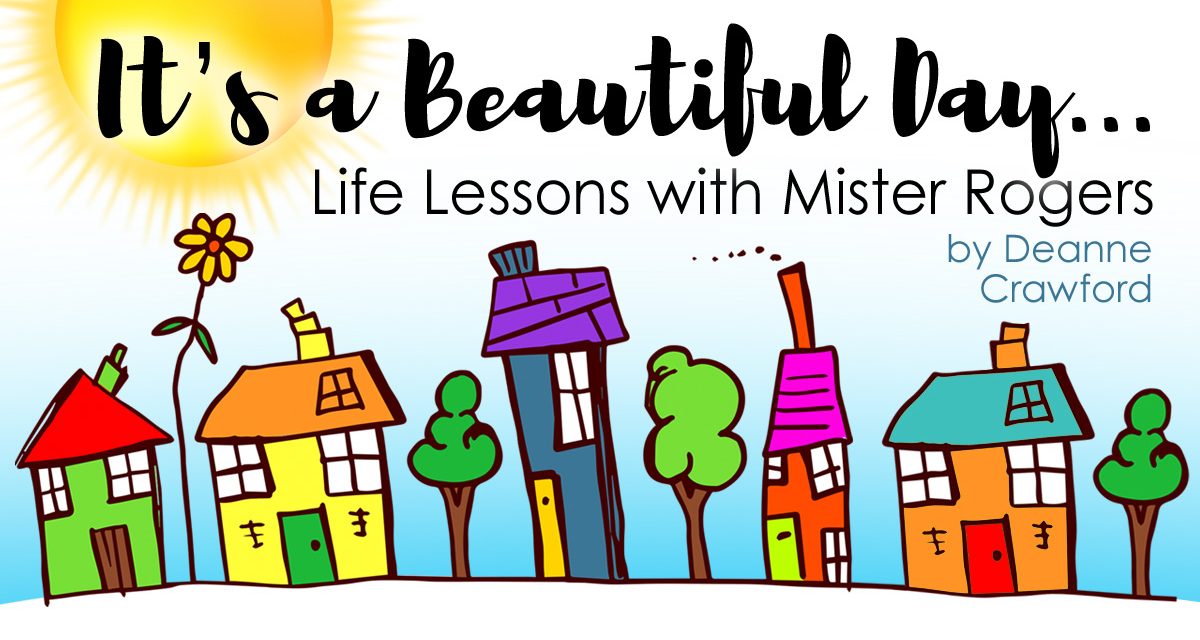“It’s a beautiful day in the neighborhood, a beautiful day for a neighbor. Would you be mine? Could you be mine? …Won’t you be my neighbor?” Smiling, I imagine you singing along, basking in youthful memories. March celebrates the birthday of beloved television personality, Mr. Fred Rogers. Remembered for his gentle, compassionate voice, our unit study this month looks a bit different, as we introduce a new generation to this larger-than-life celebrity, and his message of kindness and the value of all people. Starting with a quick look at Fred Rogers, we will wrap up with a look at 3 life lessons he taught. Before we start, as a family, watch an original episode of Mr. Rogers at misterrogers.org or pbskids.org.
Fred Rogers was born March 20th, near Pittsburgh, PA. His childhood seemed uneventful until the age of 11, when his parents adopted an infant. This was challenging and difficult for Fred. Throughout childhood, he recalled being shy, sensitive, and often bullied. While peer relationships were difficult, he was blessed to spend a great deal of time with his grandfather, who taught Fred to love music and singing. Frequently, telling him, “You make my day special,” his grandfather showed love to Fred through repeating the simple phrase “I like you just the way you are,” which later became the theme for Mr. Roger’s Neighborhood.
While home on college break, and being shocked at the television programs he saw, Fred was inspired to create a children’s program. In the early 1950s, a TV in the home was relatively new–see SoftSchool’s television timeline. Fred believed television had a higher purpose: to encourage and edify for the common good. After finishing a degree in music composition, he worked odd jobs at a local television station and pursued a pastoral degree, which he felt was needed to pursue his dream of ministering to children through television. Debuting in Canada in 1963, he returned to the U.S in 1965. However, it wasn’t until 1968, that Mr. Rogers’ Neighborhood was broadcast across the U.S. Learn more about Fred Rogers here.
If you haven’t watched an episode of Mr. Roger’s Neighborhood now is a good time. Ask your children to compare this program to today’s children’s programs. They may list notable differences and may feel that Mr. Rogers is boring or there is not enough action, and they are right. There was a real difference between Mr. Rogers’ Neighborhood and most children’s television. Working closely with a child psychologist, Fred Rogers wanted to create a program that was less show, and more real communication with children. He wanted them to feel valued and loved, regardless of their circumstances. In part, this was due to the struggles Fred faced growing up and that he was discouraged from talking or sharing his feelings about. As an adult, he wanted children to feel safe in sharing their feelings. One of his puppet creations, Daniel Striped Tiger, was key to meeting this vision. A shy, gentle puppet, Daniel finds he can talk openly about his feelings when his friends love and support him. The importance of being honest with feelings in a positive way continues today through Daniel Tiger’s Neighborhood, the animated son of the original Mr. Rogers’s Daniel Striped Tiger.
Years before our current understanding of the impact television has on the imagination of young children, Mr. Rogers understood that children needed to know what they saw on television was not real. Through all the years of his program, he would speak of his television house as a place to visit, but not his real home where he lived in with his family. Explore Mr. Rogers’ television house here. Ask children how it is the same as their home? How is it different?
Let’s look at three life lessons children (and adults!) can learn from Mr. Rogers.
First, always be kind. Mr. Rogers once said, “There are three ways to ultimate success: The first way is to be kind. The second way is to be kind. The third way is to be kind.” Ask your children what it means to be kind. Encourage them to share ways they can be kind to siblings, parents, and friends. Modeling kindness is often the most effective way to teach our children. What ways can you show kindness to your children? As parents, I think we naturally try to model kindness, but we may also want to pay attention to the interactions our children have with friends, siblings, and other adults. Part of modeling kindness may be intervening and talking with another influencer in your child’s life. If you would like to study kindness, check out Keys to Character: Kindness.
Second, Mr. Rogers showed us that we are all different and that is ok. This lesson was truly the core philosophy of his program, as he chose to celebrate that children are liked for who they are. Focusing on the positive, Mr. Rogers once said, “We all have different gifts, so we all have different ways of saying to the world who we are.” Ask your children to share what gift they have that can be shared with others. Younger children may answer concretely and answer with a physical gift. Encourage them to identify the aspects of their personality that would benefit another. Are they a good listener? Are they friendly and try to include others? All of us have something that can benefit another. Take time to watch Mr. Rogers and his dear friend, 10 year-old, Jeff Erlanger. Friends since the age of 5, they met before Jeff went through a difficult spinal surgery. As an adult, Jeff spent his life championing for the rights of the people with disabilities.
Our last life lesson from Mr. Rogers is that our lives will have pain and it is helpful to share our feelings with a trustworthy friend. He firmly believed that when we talk about our feelings, they become less overwhelming and less scary, and this is especially true for children. Using the Emotion Chart from Help for Hurting Kids, ask your children to point out the face that matches how they feel. They may or may not choose to explain “why” and that is ok. Start out with them learning to identify the emotion. Help children learn to identify their emotions by choosing one facial expression on the chart and telling a story about it. Talking about feelings will come naturally for some children, but not others. Teaching Your Child to Identify and Express Emotions and Focus on the Family Canada’s Helping Your Child Identify Emotions are excellent resources to help you guide your children. To quote, Mr. Rogers, “It takes strength to talk about our feelings and to reach out for help and comfort when we need it.” Emotionally healthy adulthood begins in childhood, and as parents, it is our privilege to guide our children into emotional health. For some of us, that means learning how to be emotionally healthy in our own lives. The National Institute of Health’s Emotional Wellness Toolbox has some excellent strategies for becoming emotionally healthy.
Thank you for joining me this month in our look at the life and lessons of Mr. Rogers. I have been challenged and blessed through my research and journey into this amazing man. I pray it has been a blessing to you as well.
~ Deanne





